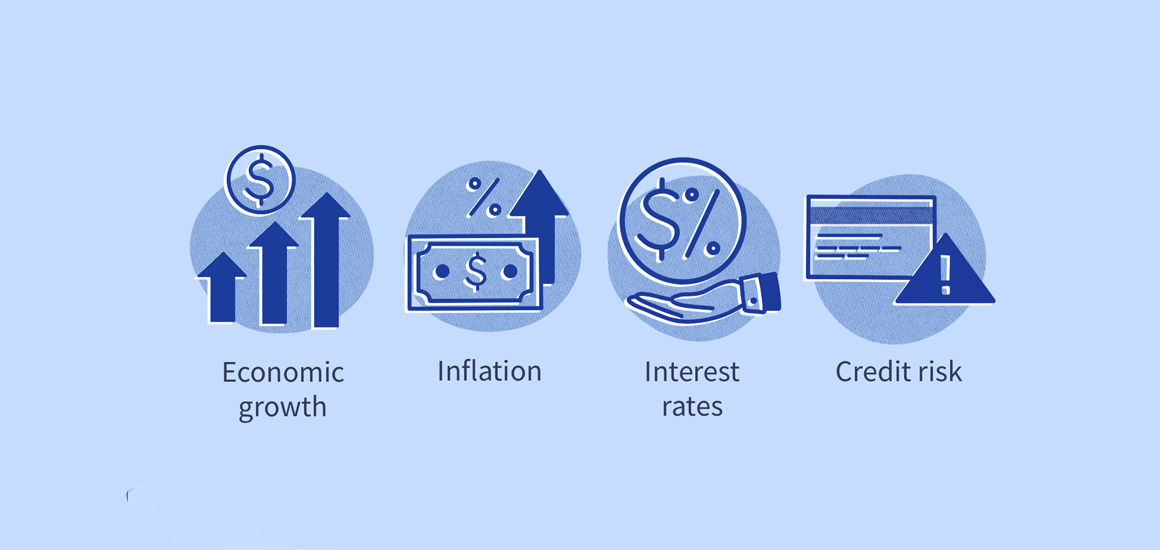As an investor, whether a beginner or an experienced one, you understand the workings of the market and the different investment tools available. Corporate bonds are considered as a relatively safer investment option available in the market. Although the returns may be long-term, they provide more stability and less risk over a period of time.
There are various factors that can affect a corporate bond, such as the maturity date, interest rate, minimum investment amount, and more. One of the essential factors that determines the effectiveness of a corporate bond is the corporate bond yield. It is generally the amount that a corporate bond yields after a certain amount of time to the bondholders. Now, this yield is affected by the different kinds of influential factors related to the corporation as well as the overall economy of the nation.
The yields of corporate bonds are affected by a few economic factors that can impact the stability and profitability of an investor. You definitely must know this to make the right move when you are investing or while you have invested.
Key Takeaways
- Corporate yields are higher due to higher interest rates.
- The increased demand during a strong economy can lower the yields, whereas the yields rise due to the increase in perceived risk during a weak economy.
- Bond yields rise when inflation rises, as investors in the market demand higher returns to offset the loss of purchasing power.
- There is fluctuation in bond yields depending on the market dynamics of demand and supply.
- Higher yields are normally offered by companies with higher credit risk, which is to compensate for the risk an investor takes to lend them money.
What are Corporate Bond Yields?

The umbrella term used to describe the return on your bond investment is yield. Indicating the degree of riskiness with respect to the issuing corporation, corporate bond yields are also impacted by macroeconomic influences. During the term of the bonds, investors earn interest, and when the bond matures, they get their face value back. Investors can buy bonds for a premium that exceeds their face value or at a discount that is less than the face value of the bond. The yield they receive on the bond will vary depending on what they purchase.
There is an inverse relationship between the price and the yield of a bond. This implies that yields decrease when bond prices rise. On the other hand, the bond’s price decreases as the yield increases.
Yield to Maturity
It is the total interest rate earned by a bond investor who purchases a bond at market value and keeps it until it matures. It can be different from the bond’s coupon rate and is often stated as an annual rate. It is dependent on the timely payment of principal and coupons. Furthermore, it does not account for the investor’s taxes or the purchaser’s brokerage fees.
Yield to Call
It is determined using the bond’s call value and the call date. The computation considers the effect on a bond’s yield if it is called before maturity, using the earliest possible call date set by the bond issuer.
Yield to Worst
The lowest yield that may be earned on a bond with an early withdrawal option is known as the yield to worst. Most of the time, yield to call and yield to worst are the same. Since yield to worst indicates a return for a shorter investment time, it always has to be lower than yield to maturity.
Coupon Yield
This refers to an annual interest rate that is decided when a corporate bond is issued. Throughout the bond’s duration, this amount stays fixed.
Current Yield
This is determined by the coupon (or interest payment) and bond price. As a result, when the bond’s price changes, so does its yield.
Economic Factors Affecting Corporate Bond Yields

The corporate bond yields of different companies do not entirely depend on company factors; they are also affected by the economic factors prevailing in the country. Here are certain economic factors that affect corporate bond yields India.
Economic Standing
The current state of the economy can have an influence on corporate bond yields. Bond yields might fall in a rising economy as a result of increased demand for the securities. On the other hand, during recessions, investors may view bonds as riskier, which would raise yields.
Rate of Interest
Inflation risk causes central banks to boost targeted interest rates. Whenever the risk-free rate of interest increases, corporate bond yields need to rise in parallel to adapt. Higher yields result in lower costs, which makes the economy even more subject to unexpected events. Therefore, in the event that the economy enters a recession and profits decline, yields might increase as expenses rise.
Supply and Demand
The bond yield swings according to the bond’s present value in the secondary market, which is affected by demand and supply patterns. For example, the yield will be less than the coupon rate if the bond’s present price on the market is more than its nominal value.
Inflation
Profit margins become thinner by rising wages brought on by inflation, leaving them more open to slowdowns in economic development. Additionally, inflation drives up overall economic prices. As prices grow, so does people’s capacity to pay for them, which enhances credit risk and puts a price increase on corporate bond yields.
Credit Risk
Credit risk, or default risk, is a company-specific characteristic that isn’t always related to economic circumstances but nonetheless demonstrates a company’s standing in the marketplace. Several agencies provide credit ratings with the objective of identifying and classifying credit risk.
While there are numerous methods that can be used for analysing and evaluating credit risk, interest-coverage ratios, and capitalization ratios are two common measurements. Corporate bonds issued by companies with greater credit risk will have higher interest rates to offset the added risk.
In addition to understanding what impacts corporate bond yields, it’s also important to explore the differences between bond funds and individual bonds. If you’re considering an investment in the bond market, you can learn more in our detailed guide on What Makes Bond Funds Different from Bonds.
Best High-Yield Corporate Bonds

Following is the corporate bond yield data for the best corporate bonds providing high-yield corporate bond rates in the market.
| Corporate Bond | Yield | Payments |
|---|---|---|
| Tapir Construction Limited | 13.92% | Monthly |
| Lendingkart Finance Limited | 12.65% | Monthly |
| MAS Financial Services Limited | 10.98% | Monthly |
| Navi Finserv | 10.50% | Monthly |
| ECL Finance Limited | 10.16% | Yearly |
| Indostar Capital Finance Limited | 9.51% | Quarterly |
| Star Health and Allied Insurance Company Ltd | 8.93% | Yearly |
Discover more about investing in bonds by exploring our guide on Are High-Yield bonds a good investment for you?
Smart Investing with GoldenPi
Corporate bonds are prevalent in nearly every sector of the economy, make a significant contribution to economic development, and offer an assortment of undeniable benefits. As an investor, understanding about corporate bond yields and how the economic factors in India impact them is essential for better investments. GoldenPi provides you with a user-friendly platform to evaluate different investment options and choose the perfect corporate bond for your portfolio. We have the entire list of the best high-yield corporate bonds in the market, along with their creditworthiness, payment terms, and more features.
Start investing smart; sign up today on GoldenPi and invest in your future!
FAQs on Corporate Bond Yields India
1. What economic factors influence corporate bond yields?
Factors such as inflation, supply and demand, interest rates, economic stance, and credit risk influence the yields of the bonds. The yields increase with an increase in interest rates and inflation. The strong economy and high demand for bonds will lower yields. If the bonds are offered by companies that have higher credit risk, they offer bonds with higher yields to compensate for the risk added to the investor.
2. What economic factors influence corporate bond yields?
Factors such as inflation, supply and demand, interest rates, economic stance, and credit risk influence the yields of the bonds. The yields increase with an increase in interest rates and inflation. The strong economy and high demand for bonds will lower yields. If the bonds are offered by companies that have higher credit risk, they offer bonds with higher yields to compensate for the risk added to the investor.
3. What happens when bond yields rise?
When bond yields rise, the value of existing bonds falls. The rise or fall in bond values mainly applies to the value of a bond on the open market, which means that if the bond gets sold before maturity, the person selling it will receive a higher or lower price for the bond than the bond’s market value, based on the prevailing interest rate.
4. Is bond yield the same as an interest rate?
The annual interest rate paid by a bond is known as its coupon rate, and the rate of return it produces is known as its yield.
5. What is a corporate bond’s yield to maturity?
The total interest rate obtained by an investor who purchases a bond at market value and maintains it until maturity is known as yield to maturity, or YTM.
6. Do bonds crash during a recession?
Bonds are more likely to do well during a recession than stocks because investors lean toward bonds during times of recession. This is simply because stocks carry greater risk due to their increased volatility under weak market conditions.
7. Are high bond yields good or bad?
While rising yields may cause short-term financial losses, they may also pave the way for higher returns in the future. You can get better yields on new bonds while interest rates are increasing. The portfolio generates greater profits over time than it would have produced if interest rates were to remain lower.






